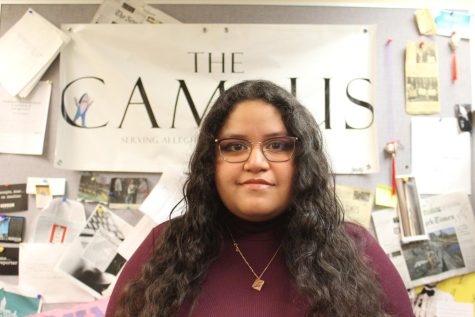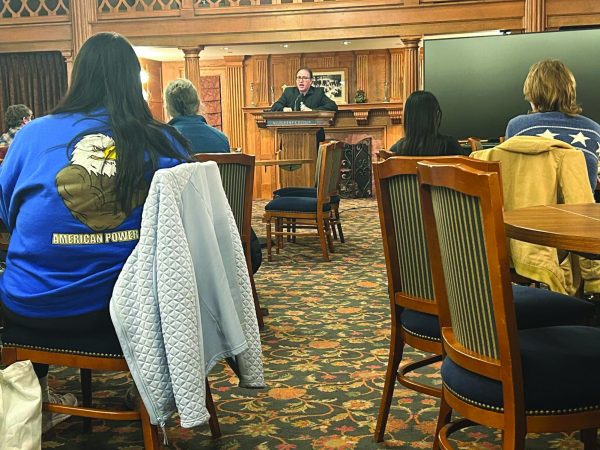Hamline University fires prof. after art controversy
Allegheny reacts to Hamline debate
Adjunct Professor of Art at Hamline University Erika Lopez Prater was fired after showing students images of the Prophet Muhammad in an art history class. The situation has sparked a conversation about academic freedom and religion.
Director of Spiritual and Religious Life Sami Alkyam explained that most Muslims oppose depictions of Muhammad or any other religious figures because they can be worshiped instead of Allah.
“The vast majority of Muslims oppose the depiction of the Prophet in images, statues or anything,” Alkyam said. “It may mystify many non-Muslims and I understand this, but it speaks very central to the issue and the pillar of Islam which is the worship of God alone.”
The Muslim Public Affairs Council released a statement in support of Prater, expressing that to them, it is important to support free inquiry, according to CBS. The article also mentions that students were warned before the showing of the images and were given the opportunity to speak up or leave, though none did.
The Minnesota chapter of the Council of American Islamic Relations, on the contrary, found the inclusion of the painting disrespectful and organized a new conference in support of the Muslim student who complained, according to NBC News. However, the national Council on American-Islamic Relations distanced themselves from that idea, saying in a statement they acknowledge that many Muslim artists have been drawing the Prophet for hundreds of years.
Alkyam did not agree with the statement and does not personally believe showing images of the Prophet is appropriate.
“I know that there are some Muslim scholars who argue that it is fine to show images of the Prophet,” Alkyam said. “But I know that the vast majority of scholars and Muslims do not do this themselves and do not accept it. Think of it as forbidden or taboo basically.”
In response to the debate surrounding academic freedom, Alkyam states that he does not believe that freedom of speech is a good reason to show images of the Prophet when it risks aggravating a whole community.
“Freedom of speech has its limits,” Alkyam said. “My point is that the professor started under the premise of academic freedom — which means that you can say whatever you want as long as you justify it by saying, ‘I want to teach my students.’ But what is it that you want to teach them about? The image of the Prophet? It doesn’t really add much in my view.”
Alkyam questioned if the one Muslim student in the class should have been expected to speak up against the images beforehand after being given the opportunity by the professor several times. He also made the argument that if the professor continually made disclaimers, then she knew images of the Prophet are prohibited by many.
“One of the Muslim students said that one of the most hated things for them is when people ask them to talk about Islam, because it is one thing if they are asking about (their personal views) and another if they are asking me to speak for a community,” Alkyam said. “My point is that the professor herself knew that this was problematic. I really think it’s unfair to put the heavy load of deciding upon an issue like this on the shoulders of one undergraduate in your class.”
Hamline University’s decision to not rehire Prater has been a controversial topic which, according to AP News, has resulted in Prater filing a lawsuit against the institution. Alkyam believes Hamline’s decision to cut ties with the professor is a way of advocating for the Muslim community and representing their stance as an institution.
“They are basically performing a statement which is ‘we know that this is a forbidden issue for Muslims and we respect the Muslim community here and all over the world,’” Alkyam said. “What is the gain of showing an image of in a class other than, honestly, aggravating the whole community?”
At the same time, Assistant Professor of Art History and Director of Allegheny Art Galleries Paula Burleigh highlighted labor issues at play in the situation. Burleigh did not want to take a stance in support or against Prater’s actions.
“They are an adjunct professor and that means they have minimal to no job security,” Burleigh said. “They were not given the opportunity to have a conversation around restorative justice for the student, and I think this speaks to the precariousness of adjunct labor where they are not being paid living wages and their jobs are very vulnerable.”
Burleigh believes that when it comes to religion and academic freedom in universities, an ongoing conversation with active negotiation needs to be had.
As an art professor, Burleigh thinks that when teaching with visuals it is important to situate the images in a historical context to make students better visual interpreters but also be mindful of blindsiding students with images that may harm them.
“I wish there had been more opportunity for productive dialogue afterwards to figure out how best to proceed going forward,” Burleigh said. “The faculty member issued an apology and it seems that apology was not given space to be heard.”
In the future, Burleigh thinks more conversations with students and other faculty should be had before showing images that may be sensitive to certain communities.
“I think it is really important to empower students by involving them in those conversations and I also think it’s important for faculty members to be talking to one another because then we can learn more about what is happening elsewhere,” Burleigh said.

Evelyn Zavala is a senior from San Francisco. She is majoring in Business and minoring in Journalism in the Public Interest. This is her fourth year on...








Peter Aston • Jan 21, 2023 at 10:11 am
This article has managed to completely miss the entire point. In a secular society, and particularly at an institution of higher education, you need to be able to handle hearing views that differ from your own. A classroom cannot function if it has to kowtow to the various irrational and incompatible sensitivities of every student (especially if some of those students are determined to be offended).
Barb • Jan 20, 2023 at 10:19 pm
There are many academic topics some students might find uncomfortable. The conservative Christian who doesn’t believe in geologic time and evolution. The Palestinian student who doesn’t believe Israel should exist. The vegan student who does not believe in animal testing. The Catholic who is horrified at the notion that Jesus might have had a sibling.
None of those are reasons for universities to avoid including those topics in appropriate classes. If students are afraid of being challenged, they either need to choose a university that will wrap them in cotton wool to keep them from scary ideas, or they need to grow up and understand that universities are places where ideas and knowledge will be discussed, even when the topics are uncomfortable.
The student at Hamline went out of her way to choose offense, despite plentiful guidance from the instructor that it was completely acceptable to skip viewing those images. Since the class was online, this was trivially easy. Unlike what Burleigh said, students were not blindsided. Likewise, Alkyam is also wrong about Muslims and images of the Prophet. Millions of Muslims around the world cherish and respect these images. It does not make them less Muslim.
There is a reason that these images are frequently included in art textbooks. It was entirely reasonable for the instructor to include them in her course. She went to remarkable lengths to alert students and Hamline administration via her syllabus, notified students ahead of time about what she would be showing and when, and made it clear that it was fine to skip seeing it. Just as it would be unreasonable for a biology professor to skip a presentation on evolution because some students find the concept offensive, it is unreasonable to allow a strict sect of Islam to determine what is covered in an art class, especially since in the strictest form there should be no representations of humans or animals.
Franklin F • Jan 20, 2023 at 11:11 am
I was raised in a strictly evangelical Christian household, where discussion of topics such as the historical and social construction of Christian beliefs was considered deeply offensive. Learning about evolution in high school biology caused me to seriously question the religious views I was raised with. When I went to university, I took additional biology classes and secular Biblical history courses, leading me to move beyond my parents’ interpretation of Biblical literalism. This was a difficult growth process, but having gone through it, I am confident in who I am, what I believe, and open-minded to learning more.